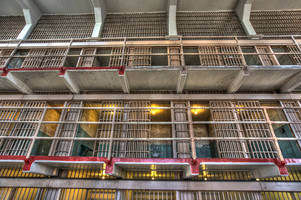
At least, that’s how it has worked in much of the country since the 1990s, when getting tough on crime was the one thing politicians could agree on, their only disagreement
| | being over which of them was toughest. Now it turns out this is old-fashioned thinking. States today are finding ways to effectively deal with bad boys and girls without forcing them into an unwanted relationship with a cellblock bully. We used to call this “coddling.” Now we call it effective rehabilitation, and it seems to be working. Utah lawmakers should take note. If they sent any message loud and clear during the just completed session, it is that they want the state prison moved from Draper. The House and Senate passed a joint resolution, with only token opposition, that concludes it is in the state’s best interest to do so. The only thing they don’t seem to know is where to move it. When I spoke with Gov. Gary Herbert during the session, he was less enthusiastic about moving the prison, saying, “It’s about prison reform first, and economic development second.” Turns out he was onto something. A new report by the Pew Charitable Trusts uses statistics from the FBI and the Bureau of Justice to show that, in most states, crime rates are on the decline, and so is the rate at which criminals are being sent to prison. For years, the reduction in crime rates was thought to be at least partly the result of laws that put more people behind bars. The thinking was that if you removed the criminal element from the streets, there would be no criminal element on the streets. Turns out this is old-fashioned thinking, too. Most of the criminal element was going to find its way back to the streets sooner or later. When the recession hit, it became difficult to come up with the $52 billion the states combined paid for corrections. The Pew study credits three factors for the current trend. One has to do with spending money on treatment and diversion rather than on building new cells. Texas spent $241 million in these programs. Since 2007, the state has seen a 39 percent drop in the prisoners who fail at parole, crime has fallen to levels not seen since hippies roamed the earth and taxpayers saved $3 billion in unspent prison construction. States find it more effective to shorten prison sentences for lesser offenses and steer people toward programs rather than hard time. The second factor has to do with strong public support. People want low-level offenders to stay out of prison because they don’t want to pay for them to be there. What people want eventually ends up finding its way into political platforms. Third, states are using actual research to drive the kinds of alternatives offered to inmates. Things like “cognitive-behavioral therapies that improve impulse control,” with tough consequences for those who violate rules and rewards for those who do well, seem to work. California, of all places, is leading the way. In 2012, it housed 26 percent fewer prisoners than in 2007, the Pew study found. Its crime rate also fell by 11 percent during that time. Fourteen other states saw an inmate population drop of 10 percent or more during the same time. Only 15 states increased their prison populations, and most of them also saw a reduction in crime. Give all that is at stake, Utahns should begin asking why its incarceration rate hasn’t dropped along with the crime rate. It’s not just a factor of the state’s high growth rate. Yes, Utah was the third fastest growing state from April 1, 2010 to July 1, 2013, but Texas was second, and its incarceration rate is down 11 percent. Moving the Draper facility may be an inevitability. But putting more resources into reforms, as other states are doing, may pay off more handsomely in the long run. |

 RSS Feed
RSS Feed

